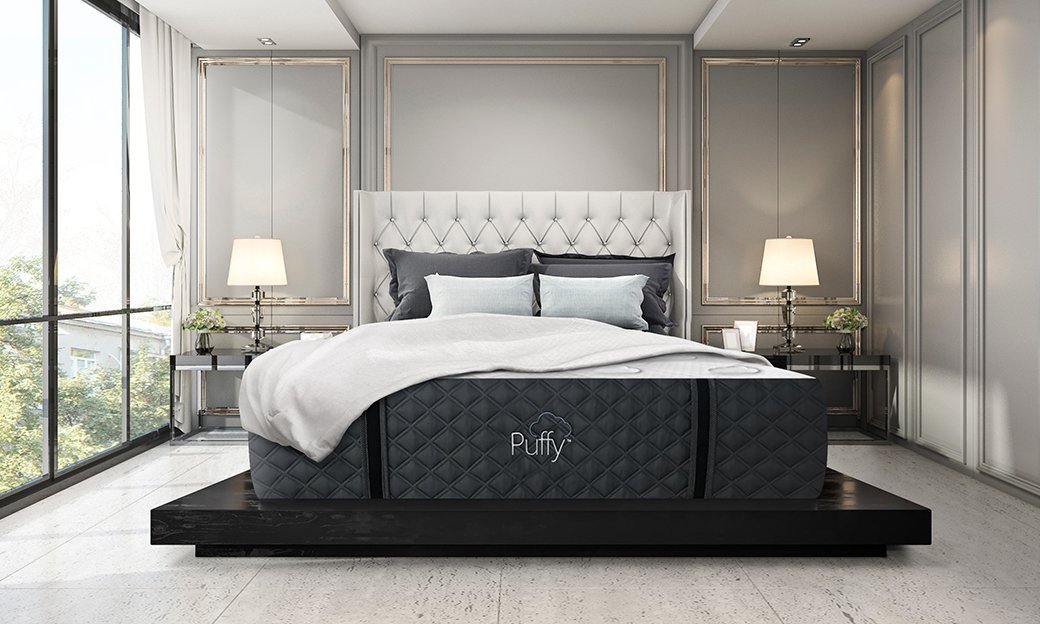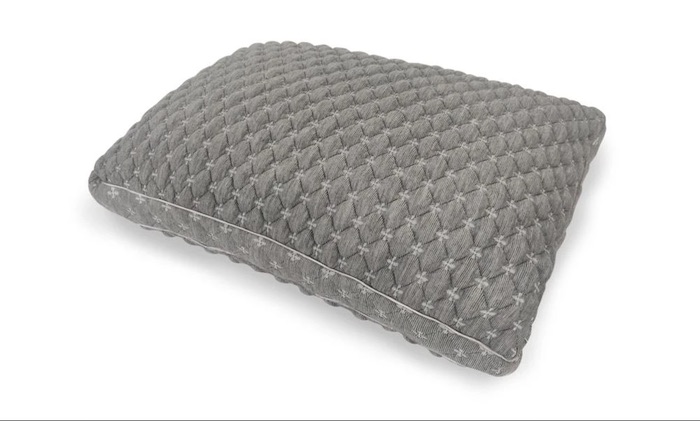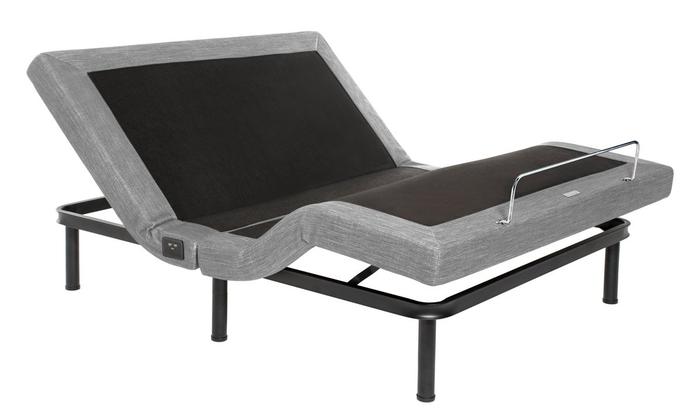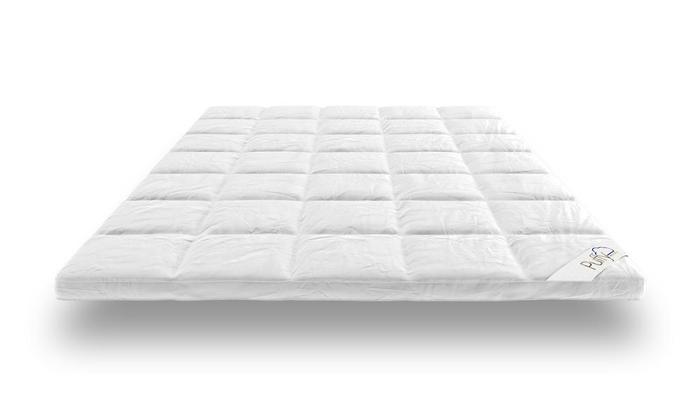Meet Our Testing Team

Jackson

Elizabeth

Scott

Mari
Recommended for...
- Lightweight sleepers. While heavier sleepers may also enjoy the Puffy, it is an ideal fit for those below 130 pounds. Lighter sleepers compress the foam less, so firm mattresses can feel uncomfortably hard. The Puffy, with its medium firmness and extra-soft sleep surface, offers lightweight sleepers both pressure relief and support.
- Side sleepers below 230 pounds. People who sleep on their side can sometimes develop pressure points at their hip and shoulder. The Puffy remedies this with highly contouring memory foam, which compresses at potential pressure points while curving to support the waist.
- Customers interested in exceptional pressure relief. Our pressure mapping tests showed that the Puffy offers excellent pressure relief for all sleeper types, even when compared to other memory foam models. However, average-weight and heavier sleepers may find it to be too soft.
Not Recommended for...
- Sleepers over 230 pounds. As a medium mattress with a soft sleep surface, the Puffy is unlikely to offer heavier sleepers the support they need. At 10 inches tall, its comfort layers may also be too shallow for some heavy sleepers.
- Stomach sleepers. While the Puffy may be appealing to some people who sleep on their stomach, others will find that their hips tend to sink out of alignment with their spine. Over time, this can cause stiffness and back pain.
Video Review
Although we’ll cover everything you need to know about the Puffy Mattress in this review, it’s worth seeing it (and our testing team) in action. Watch the video below to see how the Puffy performed, as well as how our team came to their conclusions.
Ratings Summary
Our testing team conducted an extensive evaluation of the Puffy mattress. This review and rating process consists of three parts: in-house evaluation, external sleep testing, and data collection of verified owner experiences. To learn more about our review process, read our methodology here.
Our performance criteria and ratings for the bed are listed in the table below.
While the Puffy excelled in pressure relief, noise, and motion isolation, our testers found that it under-performed in the durability and sex categories. Read below to learn more about what these ratings mean, as well as how we made our decisions.
Sleep Position Ratings
As part of our ratings process, we evaluated the Puffy mattress across different body types and preferred sleep positions. In addition to physical testing, we surveyed our sleep expert team and analyzed reviews from verified mattress owners and customers. Our findings are listed in the table below.
For more information on sleeping positions please see our guides for side, back, stomach and combination sleepers.
Puffy Mattress Awards
After analysing the results of our testing, as well as reviews from verified customers, we’ve found a category where the Puffy offers standout performance.
-
Best Soft Mattresses
Best Soft Memory Foam for Best Soft Mattresses.
How Is the Puffy Mattress Constructed?
Cover
The Puffy’s soft, stretch-knit cover is 100 percent polyester and thin enough to allow for airflow. In addition to being stain-resistant, the cover can be completely unzipped and is machine-washable. This contrasts with the integrated covers used by many of the Puffy’s competitors and makes this mattress a good choice for people concerned about staining and washability.
Comfort Layers
Two foam layers, each two inches deep, make up the Puffy mattress’s comfort system. The first is a gel-infused “Cooling Cloud” memory foam layer, which offers deep, pillowy pressure relief and a soft feel. Foam infused with gel, like the kind used here, may also have better temperature regulation properties than standard memory foam.
The Puffy’s second layer – composed of “Climate Comfort” polyfoam – does double duty as both a comfort and transition layer. This foam is temperature-resistant and denser than memory foam, offering support for the initial comfort layer while preventing sleepers from sinking through to the firmer support core.
Support Layers
The Puffy has a 6-inch base layer of high-density (1.5 PCF) “Firm Core Support” polyfoam. This is a standard construction for all-foam mattresses. The dense foam is stronger than the softer comfort layers and serves to stabilize the bed and prevent excessive sagging.
Mattress Height
At 10 inches, the Puffy is an average height for an all-foam mattress. With four inches of comfort layering, it still provides enough depth to prevent most average and lightweight sleepers from sinking against the support core.
| Product Name | Firmness Rating | Thickness | Support Core Components | Comfort Layer Components | Cover Components |
|---|---|---|---|---|---|
| Puffy Mattress | 5 (‘Medium’) | 10″ | 6″ ‘Firm Core Support’ HD Polyfoam | 2″ ‘Cooling Cloud Gel’ Memory Foam 2″ ‘Climate Comfort’ Polyfoam |
100% Polyester |
What Are the Firmness and Feel Like?
The Puffy is rated at 5 out of 10 on our firmness scale, giving it a true medium feel. However, due to its 2-inch comfort layer of low-density memory foam, it has a deep, highly contouring sleep surface that feels softer and more cradling than medium-firmness mattresses constructed from other materials.
Memory foam’s outstanding pressure relief and low motion transfer are both the result of its high point elasticity. This quality allows it to compress directly beneath any point where weight is applied, rather than radiating around the pressure. Our testing team found this created the sensation of sleeping ‘in’ their mattress, rather than on top of it.
Compared with some of its competitors, the Puffy’s memory foam is relatively responsive. However, people with mobility concerns which make it difficult to change position, or sleepers who dislike the feeling of sinking into their bed, may be more comfortable with a less conforming mattress.
Ratings Breakdown
Performance Ratings
Next, let’s take a closer look at our performance ratings for the Puffy mattress. We base these ratings on findings from our internal testing and sleep testing results, along with verified customer and owner experiences.
Durability
Puffy has only been operating since 2017, so we primarily relied on its construction and materials when determining its durability. Synthetic all-foam mattresses like the Puffy tend to be less durable than those which use latex or coils, but the Puffy still received lower marks here than some similarly constructed beds.
Its use of low-density (2.5 PCF) memory foam allows for a soft sleep surface, but density also factors into durability. Less-dense foams are often less durable, and the Puffy will likely have a shorter lifespan than mattresses using denser foams. However, lightweight sleepers may not see as much deterioration, while heavier sleepers will likely find their mattress sags more over time.
Motion Isolation
Our sleep testers gave the Puffy top marks for motion isolation, reporting that they could feel very little referred movement when their sleep partner shifted positions or even got out of bed. Sitting on the edge of the bed did cause the mattress to dip, sometimes significantly, but this was isolated enough not to disturb even light-sleeping bed partners.
These results didn’t come as a surprise to us, as all-foam mattresses (and those using memory foam in particular) tend to have excellent motion isolation due to their high point elasticity. However, both our in-house testing and our sleep tests showed that the Puffy performs remarkably well in this category, even when compared to some memory foam competitors.
Off-Gassing
Upon unboxing, the Puffy had a noticeable off-gassing odor. This faded significantly over 24 hours, and any lingering scent dissipated within 48 hours. Most of our sleep testers reported that they would have no concerns sleeping on the bed after the initial 24 hours, giving the Puffy an average grade in this category.
Off-gassing is caused by volatile organic compounds (VOCs), which are a byproduct of foam manufacturing. Although their smell is unpleasant (comparable to plastic or rubber), VOCs are relatively harmless and will fade from the Puffy reasonably quickly.
Pressure Relief
Our sleep testers were highly impressed by the Puffy’s outstanding pressure relief. Few experienced any pressure points, and they appreciated that the memory foam comfort layer allowed for deep, body-hugging support. This was particularly true for our side sleepers, who found that the mattress conformed to their curves for good spinal alignment and minimal next-day stiffness.
However, our heavier back and stomach sleepers, while still reporting few areas of increased pressure, did find they sank into the memory foam layer more deeply.
Our in-house pressure mapping tests backed up the experiences of our testers. The comfort layers evenly distributed weight and minimized pressure points, an effect which was most noticeable for side sleepers and those below 230 pounds.
Temperature Neutrality
Although our testers found that the Puffy sleeps warmer than mattresses with less conforming qualities, they also reported that it has better temperature neutrality than some of its memory foam competitors.
For some testers who sleep very warm, the Puffy sometimes became uncomfortably hot after several hours. Other testers, however, said that they remained within a comfortable temperature range throughout the night.
Memory foam absorbs and retains heat, and its cradling effect lessens airflow. Together, these qualities mean that synthetic foams tend to sleep hot. However, the Puffy features gel-infused memory foam and temperature-neutral polyfoam, both of which allow for better temperature neutrality.
Edge Support
In our testing, we found that while the Puffy offers decent edge support for an all-foam model. Testers found that sitting on the side of the bed resulted in some sinkage, but not an excessive amount. As part of a recent model redesign, Puffy improved the edge support of this mattress to make it feel more stable for sleepers.
Overall, the Puffy should offer enough reinforcement for most people, particularly light or average-weight sleepers. However, customers looking for a strong perimeter may be better served by a hybrid or innerspring mattress.
Noise
One of the benefits of all-foam mattresses is that they are nearly silent, and our sleep testers reported that the Puffy is an extremely quiet mattress. Even our testers who are sensitive to noise at night found that the Puffy was silent, both when climbing into bed and while shifting position. This is due to both the lack of moving parts, such as coils, and the natural dampening qualities of foam, which muffles any small creaks or other sounds.
Sex
The same qualities which earned the Puffy an excellent score in pressure relief caused problems for it in this category. Memory foam, particularly the extra-soft, low-density variety used by Puffy, offers very little ‘bounce’. Additionally, though the foam returns to shape reasonably quickly, the cradling sensation and the delay in responsiveness can make changing positions more difficult.
The Puffy does offer some benefits in this category, such as very low noise and increased traction across the mattress surface. Edge support is also above-average compared to other all-foam models. However, its drawbacks resulted in a lower score.
Sleeper Ratings
In this section, we’ll cover how well the Puffy performed in different weight categories.
While everyone has their own preferences, mattresses will be more or less suitable for different people depending on their weight and preferred sleeping position. To stay objective and help readers find their ideal mattress, our sleep testing team consists of people with a wide range of body shapes and sleep position preferences.
Lightweight Sleepers – Less than 130 lbs.
Overall, the Puffy was most suitable for our lightweight sleep testers. The combination of a medium firmness level with an extra-soft memory foam comfort layer proved particularly comfortable for side sleepers in this category, who found the mattress to offer an ideal balance of support and cradling pressure relief.
Side sleepers tend to dig in at their shoulder and hip, and the Puffy was able to prevent pressure points in these areas while still gently supporting their waist for improved spinal alignment.
Although the Puffy is also a very good choice for back sleepers below 130 pounds, our stomach sleeping testers reported that their hips tended to sink against the memory foam layer, causing their spine to fall out of alignment.
Average Weight Sleepers – 130 to 230 lbs.
As with our lightweight testers, our average weight side sleepers found the Puffy to be more suitable than their stomach and back sleeping counterparts. The excellent pressure relief cradled their shoulders and hips while still allowing for proper spinal alignment, and few reported next-day stiffness. However, there were some outliers, particularly heavier average weight sleepers, who found the Puffy to be slightly unsupportive.
Average weight back and stomach sleepers also reported a lack of support. While both groups felt that the Puffy offered them a good night’s sleep, they did experience some stiffness due to their hips moving out of alignment with their spine. In general, sleepers in this category who prefer softer mattresses will likely appreciate the Puffy more than those who prefer a firmer sleep surface.
Heavyweight Sleepers – More than 230 lbs.
Although the Puffy is considered a medium-firmness mattress, it has an extra-soft sleep surface made from low-density memory foam. Most people above 230 pounds tend to prefer medium-firm or firm mattresses, as these offer improved support while still feeling softer than they would for a lighter sleeper.
Given this, it did not come as a surprise that our heavier sleep testers gave the Puffy lower scores. As in the other categories, the mattress was most suitable for side sleepers. However, our heavier side sleepers received less support than their lighter counterparts, as the memory foam compressed more and therefore offered decreased pressure relief.
Heavier stomach and back sleepers also found the Puffy significantly lacking in support, particularly for their lower back and hips.
Pricing and Discounts
- Twin $599
- Twin XL $649
- Full $799
- Queen $949
- King $1,149
- Cal King $1,149
Puffy Coupons and Promos
Get $455 worth of free accessories with any mattress purchase.
Our readers enjoy big discounts.
How Does the Puffy Mattress Compare to Other Beds?
We repeat our testing process for every mattress we review, giving us the chance to notice the similarities and differences among a wide variety of mattresses. In this section, we’ll compare the Puffy against its competitors and share the information you’ll need to make a decision.
In addition to their flagship model, Puffy also sells two luxury mattresses: the Puffy Lux, and the Puffy Royal.
The Puffy vs. Puffy Lux
At 12 inches tall, the Puffy Lux is visibly thicker than the company’s flagship model. This is due to the Lux’s additional comfort layering — an extra inch of memory foam, and two 1.5-inch polyfoam layers, one temperature-resistant, rather than one 2-inch layer — as well as its 7-inch high-density polyfoam support core.
Overall, the Lux is very similar to the original Puffy, though with luxury features and a matching, higher price point. Both share similar qualities, such as outstanding pressure relief, and faults, such as reduced durability. However, the Lux improves on the Puffy by offering a thicker comfort layer that contours and more deeply and provides added reinforcement.
Instead of sinking so far into the bed, sleepers are offered upgraded support paired with the exceptional pressure relief Puffy is known for. This is particularly useful for heavier sleepers, who may find they sink through the original Puffy’s comfort layers and rest against the firmer support core.
Given its rating of 6 out of 10, the Puffy Lux is considered a medium-firm mattress, making it potentially more suitable than the softer Puffy for average-weight and heavier sleepers.
Read our full Puffy Lux Mattress Review.
The Puffy vs. Puffy Royal
Puffy’s top-of-the-line offering, the Puffy Royal, is a medium (5.5 out of 10) mattress with an extra-thick 14-inch profile. Like the Lux, the Royal builds on the basic Puffy’s construction with specialized foams and thicker layers, as well as a higher price. The top, 1.5-inch comfort layer is made from gel memory foam, followed by 2-inch layers of standard memory foam and temperature-resistant polyfoam. Finally, a 1.5-inch layer of convoluted polyfoam transitions to the Royal’s 7-inch high-density polyfoam base.
The Royal has a slightly more resilient ‘bounce’ than the other two Puffy models. Testers still felt as though they were sleeping ‘in’ the mattress, but they also experienced a more ‘floating’ sensation when compared to the Puffy’s deep cradle. It is also more durable, and has better temperature regulation for a cooler sleep.
Though not significantly firmer than the Puffy, the Royal is a better choice for average-weight and heavier sleepers, particularly back and side sleepers. This is due to its use of zoning, altering the foam in certain areas to better support weight variations throughout the body. Denser foam in areas of increased weight (like the pelvis) provide better spinal alignment, while softer foam in areas like the shoulders help prevent pressure points.
While Puffy offers a range of all-foam mattresses, the Puffy’s competitors also include beds made by other brands. Read through the comparisons below to learn more about how the Puffy stacks up against two other choices.
Read our full Puffy Royal Mattress Review.
The Puffy vs. Loom & Leaf
Made by Saatva, the Loom & Leaf is an all-foam mattress with two 2-inch memory foam comfort layers. Although more expensive than the Puffy, the Loom & Leaf does offer a choice of firmness levels — medium (5.5 out of 10) and firm (8 out of 10) — and stands two inches taller than the 10-inch Puffy. It also features an integrated organic cotton cover quilted with foam for additional comfort.
The Loom & Leaf uses materials not found in the Puffy, including a top layer of convoluted foam which has been laminated with cooling gel. Convoluted foam’s open structure improves airflow (and therefore temperature neutrality), as well as providing pressure relief which feels less confining than traditional memory foam.
Another notable difference between the Puffy and Loom & Leaf is the latter’s use of higher-density memory foam. Its two memory foam layers have densities of 5 PCF and 4 PCF, giving them a medium density in comparison with the Puffy’s layer of 2.5 PCF memory foam. This provides the Loom & Leaf with a slightly firmer-feeling surface, though one which still offers excellent pressure relieving qualities.
Due to this, and the ability to choose a firmness level, the Loom & Leaf received high scores for all side-sleepers, as well as good scores for other weights and sleep preferences.
Read our Full Loom & Leaf Mattress Review.
The Puffy vs. the Casper
An all-foam bed that retails for less than the Puffy, the Casper shares many of the Puffy’s qualities despite its different build. Two 1.5-inch comfort layers (one made of polyfoam, one made of medium-density memory foam) are followed by a 1.5-inch transitional polyfoam layer, and a 7.5-inch high-density polyfoam support core.
Like the Puffy, the Casper is considered a true medium (5 out of 10) mattress, though with a slightly firmer feel to the touch due to its use of denser memory foam. Both the Puffy and the Casper are more suitable for lightweight and average-weight sleepers, as neither is firm enough to offer proper support for heavier individuals. Likewise, both mattresses provide the deep pressure relief and waist support required by side-sleepers.
However, though the two mattresses share similar sleep ratings, there are some differences. The Casper edges ahead for durability, due to its use of denser foams with higher PCF ratings. However, although the Puffy’s softer foams decreased its durability score, their pillowy feel provided the Puffy with a better grade in pressure relief. Read more about the differences between these two beds in our Puffy vs. Casper Comparison.
The Puffy vs. Nectar
A memory foam mattress that retails for less than the Puffy, Nectar shares some of the same qualities. The nectar has more dense foam in it’s comfort layers but they are similar in feel to the Puff.y
The Nectar mattress is firmer than the puffy as a medium firm (6.5 out of 10) mattress, due to it’s denser memory foam in the comfort layers. Given this we recommend the Puffy for lighter weight sleepers, especially side sleepers, but for heavier weight sleepers, the Nectar’s firmness is likely ideal.
However, though the two mattresses share similar sleep ratings, there are some differences. The Nectar edges ahead for durability, due to its use of denser foams. However, although the Puffy’s softer foams decreased its durability score, their pillowy feel provided the Puffy with a better grade in pressure relief. Read more about the differences between these two beds in our Puffy vs. Nectar Comparison.
 |  |  |  |  | |
| MATTRESS TYPE | |||||
| PRICE RANGE | |||||
| FIRMNESS OPTION | |||||
| AVAILABILITY | |||||
| SLEEP TRIAL | |||||
| WARRANTY LENGTH |
Read More Puffy Comparisons
Puffy Mattress FAQ
-
Sleep Trial 101 nights
-
Shipping All 50 states
-
Warranty Lifetime warranty, non-prorated
-
Made In USA
-
Where Can I Buy Puffy Mattresses?
Puffy mattresses are available only online, through the Puffy website.
-
Where Do They Ship?
Puffy ships mattresses anywhere in the United States and Canada.
-
White Glove Delivery?
Puffy does not offer White Glove delivery at this time.
-
Old Mattress Removal?
Because Puffy coordinates all deliveries through FedEx and does not offer full-service delivery, old mattress removal is not available at this time.
-
Full Delivery Policy
Delivery Policy
The delivery policy for Puffy mattresses is as follows:
- Puffy offers free shipping to all customers in the contiguous U.S. However, those in Alaska and Hawaii must pay additional delivery charges.
-
Trial Period and Warranty Details
Trial Period and Guarantee
Puffy offers a 101-night sleep trial for all mattresses sold.
- There is no mandatory break-in period, and customers may return their mattress at any point during the sleep trial in exchange for a full refund.
- In the event of a return, Puffy will help customers donate the mattress to a local charity.
Warranty
Puffy offers a lifetime warranty for all mattresses.
- Puffy will, at their sole option, repair or replace all mattress defects for as long as the owner retains possession of the mattress.
- Repair and replacement coverage is divided into two stages. During the first 10 years, Puffy will replace any defective mattress with a brand new model at no extra cost to the owner.
- After 10 years have elapsed, Puffy will repair or replace mattress defects. Customers may also select the Quick Sleep option, which enables them to order a replacement mattress at half the original product price. Those who opt for Quick Sleep will be able to keep their original mattress.
- Puffy will cover all shipping and handline fees associated with mattress repairs or replacements.
- The mattress ‘must be used on an appropriately sized and suitable bed frame or base.’ Using an improper support system may void the warranty.
- The warranty will cover visible sagging or indentations in the sleep surface that measure one and a half inches (1 1/2″) or deeper that do not result from owner misuse or improper foundational support. It also covers flaws in the cover, including manufacturing flaws like cracked or broken zippers, or physical flaws like unraveled seams. Other issues are not considered defects and will not be covered under the warranty.
- In order so file a warranty claim, mattress owners must submit the order number, the first and last name of the original purchaser, a written description of the defect, and a photograph or video documenting the defect.
- This warranty is exclusively reserved for original owners who purchase their mattress from Puffy or an authorized retailer. Anyone who buys or acquires their mattress from the original owner or a non-authorized retailer will not be eligible for warranty coverage.
Company Information
-
Customer Service
8 out of 10 owner experiences show customers have had a positive experience with Puffy, irrespective of whether or not they liked their mattress.
-
Company History
Puffy was launched in 2017.
-
BBB Rating
Puffy currently holds an ‘A+’ rating with the Better Business Bureau.
-
Physical Stores
Puffy does not operate any brick-and-mortar locations.
-
Contact Puffy
Contact Form | 1-800-430-8380 | Puffy.com
-
Find Puffy on Social





